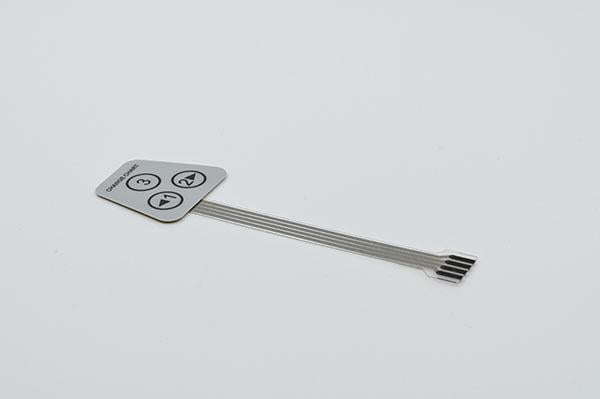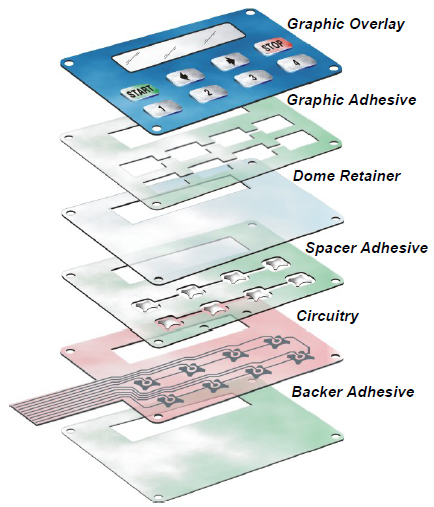What to Seek When Selecting a Membrane Change for Your Task
When you're selecting a membrane layer switch for your task, several crucial factors enter into play. You'll require to consider the materials, design, and exactly how well it aligns with your brand name. Longevity and usability are important, however so is the online reputation of the maker. Comprehending these aspects can help you make an educated decision-- one that balances quality and cost successfully. Let's explore what you must think about to ensure your option meets all your task needs.
Recognizing Membrane Layer Switch Over Components
When you dive right into the globe of membrane buttons, it's important to grasp the vital parts that make them work. Below that, the spacer layer assurances there's adequate range in between the circuit and the overlay, permitting the switch to activate without consistent pressure.
The circuit layer, usually made from printed conductive inks, produces the electrical pathways. When you press a switch, the circuit closes, sending a signal to the device. Comprehending how these layers interact assists you choose a membrane switch that's trusted and fits your project requirements. Pay very close attention to the density and product of each layer, as these elements influence longevity and capability in various atmospheres.
Product Choice and Its Impact
Picking the appropriate products for your membrane button can significantly impact its efficiency and long life. The selection of substratum, commonly polyester or polycarbonate, influences longevity and versatility. Polyester is a lot more abrasion-resistant, while polycarbonate uses far better clarity and toughness.
Following, think about the adhesive. It needs to endure environmental elements like wetness and temperature level changes. A solid sticky assurances that your membrane layer switch stays intact with time.
Don't forget the visuals overlay. The printing technique utilized, whether silkscreen or digital, affects the switch's visual appeals and longevity. High-quality inks will resist fading and damaging, keeping an expert appearance.
Last but not least, assume regarding environmental problems. If your tool will be exposed to extreme chemicals or severe temperature levels, choose materials created to endure these difficulties. Your options in products will eventually identify the switch's reliability and individual contentment.
Design Factors To Consider for Individual Experience
Picking the best materials lays the structure for an effective membrane layer switch, but the layout also plays a substantial function in customer experience. You'll intend to review exactly how the format influences functionality (membrane switch manufacturer). Keep switches and icons user-friendly and well-spaced, making it easy for users to navigate without complication

Shade and contrast are likewise essential; assurance that your style is aesthetically appealing but still practical. High comparison aids individuals conveniently recognize switches, especially in low-light conditions.
Last but not least, reflect on the total visual. A streamlined and modern layout can elevate individual understanding and make your item much more appealing. Balancing functionality with an appealing design will certainly lead to a better individual experience and ultimately, a more effective item.

Ecological Variables and Toughness
When picking a membrane switch, you need to take into consideration just how it'll carry out in different atmospheres. Aspects like temperature level resistance, moisture and chemical exposure, and mechanical wear can significantly impact its resilience. Comprehending these aspects will assist you select a switch that stands up to your details conditions.
Temperature Resistance Requirements
As environmental conditions can differ commonly, recognizing temperature resistance is essential for ensuring the toughness of your membrane button. Make sure to inspect the requirements of the materials utilized in the switch, like the glue and overlay, as they directly effect performance. By picking a membrane layer switch with adequate temperature resistance, you'll improve its lifespan and maintain functionality in difficult atmospheres.

Moisture and Chemical Direct Exposure
Dampness and chemical direct exposure can considerably affect the performance and durability of your membrane layer switch, so it's vital to understand the atmosphere in which it will be utilized. If your task involves high moisture or exposure to liquids, try to find safety layers and sealants that can enhance resistance to wetness. Additionally, think about the kinds of chemicals your button might encounter. Specific products can degrade when exposed to solvents, oils, or harsh cleaners. Choosing the appropriate products, like polycarbonate or polyester, can help stand up to these elements. Always get in touch with the manufacturer's specs for chemical compatibility to ensure your membrane button maintains its functionality over time. By focusing on dampness and chemical resistance, you can enhance the durability of your switch in challenging atmospheres.
Mechanical Wear and Tear
While you may prioritize attributes like aesthetics and performance in your membrane layer button, mechanical wear and tear can greatly impact its efficiency over time. Constant pressing can lead to deterioration of products, creating concerns like tactile feedback loss or also switch over failing. Choosing a long lasting switch warranties longevity and dependability, protecting against expensive substitutes and downtime in your project.
Modification Options for Branding
When it comes to branding your membrane button, modification alternatives are key. You can select design aspects and shades that show your brand name, together with certain logo positioning and dimension to enhance presence. Furthermore, choosing the best materials and textures can elevate the general feel and look, making your product stick out.
Layout Elements and Colors
A broad array of design components and shades can make your membrane button not just practical yet also aesthetically appealing, boosting your brand name identification. Don't neglect about textures; adding a responsive component can improve individual experience and make your button stand out. By thoughtfully choosing style components and colors, you not just develop a product that looks wonderful however also strengthens your branding continually and successfully.
Logo Design Placement and Size
After completing your style components and shades, the following step is to concentrate on logo positioning and dimension. Your logo is an essential element of your branding, so you'll want it to attract attention without frustrating various other layout components. Show on where your logo design will certainly be most noticeable and impactful; common placements consist of the leading or facility of the switch.
Think of the dimension also-- as well large and it may overshadow useful aspects, too little and it can obtain lost. Aim for an equilibrium that allows your logo to be quickly well-known while maintaining the general appearances. Don't forget to consider exactly how the logo design straightens with customer interaction. This attention to detail will enhance both performance and brand name identification in your job.
Product and Texture Options
Picking the appropriate products and appearances for your membrane layer button can substantially improve both its capability and visual appeal. You'll intend to evaluate alternatives like polyester or polycarbonate, as they provide resilience and resistance to put on. The texture of the surface area likewise plays a necessary duty; smooth surfaces provide a streamlined look, while textured surface areas can boost grip and tactile feedback.
Tailoring the products and structures allows you to mirror your brand identity effectively. You click to read could select a matte coating to communicate elegance or a shiny look for a modern-day touch. Do not forget regarding color alternatives, as lively shades can make your button stand out, while muted tones can produce a more stylish look
Cost vs. High Quality: Finding the Right Equilibrium
When you're handling the alternatives for membrane layer switches, stabilizing price and top quality can really feel frustrating. A lower-cost button could save you cash upfront, but if it endangers capability, you might face greater substitute costs later.
Search for makers that use a great mix of affordability and high requirements. Research study their track record and client testimonials to determine integrity. In some cases, investing a little bit a lot more in quality materials can save you more info here from future headaches.
Also, think about the lasting efficiency and service warranty options. A somewhat extra costly switch with a strong guarantee can show to be a smarter financial investment. Inevitably, it has to do with discovering that wonderful spot where you meet your budget plan while assuring your task's success.
Examining and Quality Guarantee Protocols
While you may locate the perfect membrane layer switch style, assuring its high quality with extensive testing protocols is important for long-lasting success. Begin by confirming that the supplier complies with market criteria, such as IPC/WHMA-A -620, to guarantee a trustworthy product. membrane switch manufacturer. You'll wish to look for thorough testing methods, including environmental, mechanical, and electrical analyses
Make particular the buttons undertake longevity screening, simulating real-world use to identify any type of possible failures. Focus on the supplier's quality control procedure, which must include regular inspections and audits.

Do not fail to remember to request examples and perform your own tests to validate compatibility with your task. Lastly, think about just how commonly the manufacturer updates their procedures; development in screening can cause improved top quality. By prioritizing these testing and high quality assurance procedures, you'll raise the probability of an effective and long lasting membrane button Web Site for your application.
Regularly Asked Concerns
Just how Long Does a Membrane Change Typically Last?
A membrane layer switch normally lasts anywhere from 1 to 10 million cycles, depending upon usage and ecological elements. You'll intend to take right into account your certain requirements to guarantee it meets your durability needs efficiently.
Can Membrane Switches Over Be Fixed if Damaged?
Yes, you can sometimes fix membrane switches if they're damaged, however it often relies on the level of the damage. Minor problems could be fixable, while more considerable damage normally needs replacement for proper functionality.
What Are the Usual Applications for Membrane Layer Switches?
Membrane buttons are commonly utilized in home appliances, medical gadgets, and automotive controls. You'll find them in consumer electronic devices, commercial devices, and even video gaming consoles. Their adaptability makes them suitable for numerous interface and settings.
Exist Details Qualifications for Membrane Layer Buttons?
Yes, there are certain accreditations for membrane layer buttons. Seek UL, CE, and RoHS certifications to assure safety and compliance. These qualifications indicate the button meets industry requirements for top quality and ecological safety.
Just how Do I Guarantee Proper Setup of a Membrane Layer Change?
To guarantee correct setup of a membrane switch, tidy the surface extensively, straighten it very carefully, and use also pressure. Adhere to producer guidelines for sticky curing time to make best use of sturdiness and capability.
Verdict
When choosing a membrane layer button for your task, keep these crucial factors in mind: prioritize resilient products, focus on straightforward layout, and think about personalization for your brand name. By meticulously examining these facets, you'll ensure your membrane layer switch not just meets your task requires however likewise boosts user experience and mirrors your brand identity properly.
Comments on “You’ll notice the difference when working with a top-tier membrane switch manufacturer.”